Union of competitors: Father Makhno and Ataman Petliura
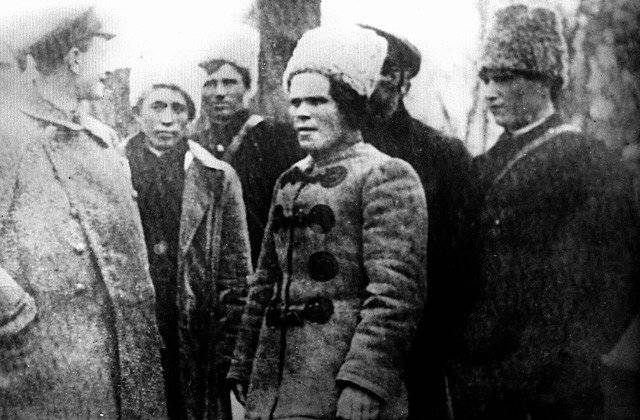
Meeting of anarchist and nationalist
Painful anger
In Ukraine, there has always been a place for various radical teachings and trends. Since the 1870s, the anarchist movement began to develop rapidly there. At the beginning of the 1905th century, two of the three largest centers of anarchism in the Russian Empire were in Ukraine - in Odessa and Yekaterinoslav (now Dnepropetrovsk). In the Yekaterinoslav province during the Russian revolution of 1907-XNUMX, the activities of one of the most famous anarchists of the XNUMXth century in the world, ataman Nestor Makhno, also began.
This activity could very quickly end on the gallows - the young worker Nestor did not distribute pamphlets of Prince Kropotkin, but was engaged in terror and expropriations. But the noose was replaced by hard labor. In the spring of 1917, Makhno, at the height of his glory as a political prisoner liberated by the revolution, returned to his native village of Gulyaipole. Political passions are seething here, various parties are fighting for the souls of local peasants, as well as workers, of whom there were also many in Gulyaipole. Almost all party agitators are socialists of various persuasions, they differ only in the degree of radicalism and also in their attitude to the Ukrainian question. The Gulyai-Polye group of anarchist-communists headed by Makhno declared itself international.
Speaking out against all parties "leading a dirty kartage struggle for power," the anarchist Makhno had a special mistrust of Ukrainian nationalists. Otherwise, as chauvinists, he did not call them. In his memoirs, Makhno wrote that the Ukrainian chauvinists “persecuted each and every revolutionary, calling him a “traitor of Nenka Ukraine” and a defender of the “katsapivs”, who, according to the “idea” of the Central Ukrainian Rada ... had to be killed, “as if they were living in a movie” ". This idea offended the peasants. They dragged the preachers off the podium and beat them. This sermon of Ukrainian chauvinists pushed the working population of the Gulyai-Polye region onto the path of armed struggle against any form of isolated Ukrainianism, because the population saw in this chauvinism, which was in fact the guiding idea of Ukrainianism, death for the revolution.
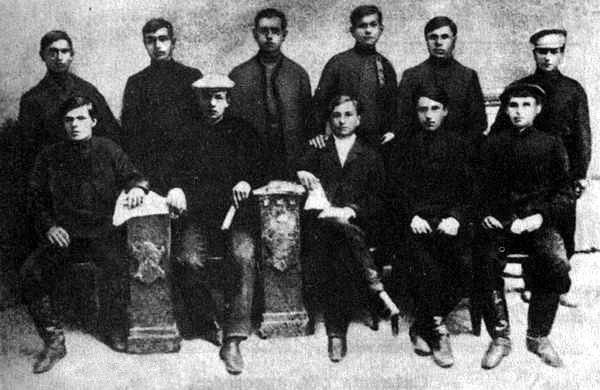
But Nestor Makhno, no doubt, was an ethnic Ukrainian, but from the south-east of Ukraine. He subsequently expressed his attitude to the problem of the Ukrainian language in his memoirs. In the summer of 1918, Nestor made his way through the Hetman's Ukraine: “And I, not knowing my native Ukrainian language, had to deform it so in my appeals to those around me that I felt ashamed ... I thought a little about this phenomenon; and, to tell the truth, it aroused some painful anger in me...” It can be assumed that his rejection of Ukrainization was based on the usual complex of an eastern Ukrainian. For a long time he had already come to terms with Russification, but he fiercely resisted the fact that his consciousness was again broken through the knee, this time in the opposite direction.
However, linguistic problems were by no means the main ones in the differences between the anarchist dad and the Ukrainian nationalists. Moreover, both with their right-wing conservative wing in the person of the Hetmans, and with the left - with the Petliurists and similar socialists. All of them, from his point of view, were simply bourgeois traitors. The only exceptions could be the Ukrainian Left SRs and ultra-left nationalists like the "Socialist-Revolutionaries-Communists" Borotbists.
national treason
Very soon, the differences between the Bolsheviks and anarchists, on the one hand, and the Ukrainian nationalists, on the other, moved from a theoretical plane to a military one. In early April 1918, the troops of the "socialist" Ukrainian People's Republic (UNR) recaptured Yekaterinoslav from the Bolsheviks and moved towards Gulyaipol. Here, in the very center of the Makhnovist movement, a conspiracy also matured, the core of which was the Ukrainianized former officers A. Volokh, L. Sakhno-Prikhodko, O. Nightingale, T. Byk, agronomist Y. Domashenko. They were also helped by individual traitors, such as Lev Schneider, a member of the Gulyai-Polye group of anarchist-communists, and Vasily Sharovsky, a Makhnovist.
The Makhnovist Nazariy Zuychenko described this coup in Gulyaipole as follows: “The conspirators replaced the company on duty at the garrison with a Jewish (central) company, which was influenced by the Jewish community, intimidated by the nationalists. It was she who played a decisive role by arresting members of the revolutionary committee, the Soviet of Workers' and Peasants' Deputies, and active members of the anarchist-communist group. Lev Schneider, our former group leader, was the first to burst into the office of our group, where he tore up banners, tore off the walls and trampled on the portraits of Bakunin, Kropotkin, and the late group leader Sasha Semenyuta. The conspirators presented our guns, machine guns, several hundred rifles as a gift to the occupiers who entered Hulyaipole, and at the rally the same Lev Schneider delivered an infamous speech. But the Gaidamaks did not like this either, and the slogans “Kill the Katsaps and the Jews – save Ukraine!” sounded anyway. Sharovsky behaved differently and at the last moment nevertheless warned the Gulyai-Polye anarchists about the danger that threatened them.
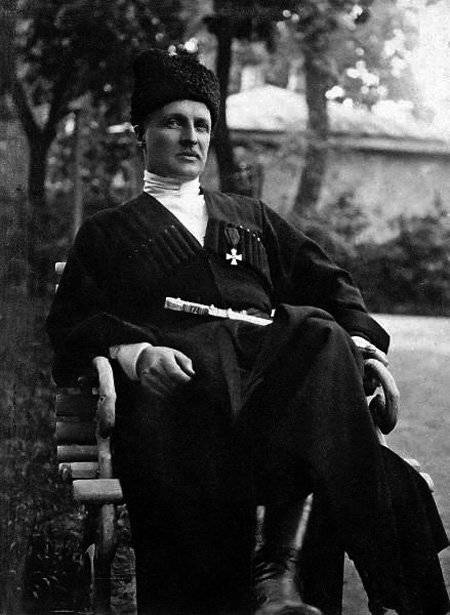
The Makhnovists did not have time to reckon with the nationalist-socialists from the UNR for the coup; on April 29, the Central Rada itself became a victim of a coup organized by their own German allies. The Germans bring to power Hetman Pavlo Skoropadsky, who was balancing between the reactionary Ukrainian nationalist landowners and the Russian Black Hundreds. The Makhnovists repaid the hetman's conservative regime a hundredfold, not for fear, but for conscience, which helped the Germans and Austro-Hungarians to pump resources out of Ukraine and rob the population. In agreement with Lenin and the Soviet government, Makhno returns to the Zaporozhye region and organizes a ruthless guerrilla war against the Haidamaks and the invaders.
Skoropadsky fully justified his name - he fell soon. But even after the Ukrainian Social Democrats and Social Revolutionaries restored the republic at the end of 1918, Makhno continued to focus on an alliance with the Soviet government. Despite all the contradictions and the subsequent tragic denouement, the Bolsheviks have always been the only strategic ally of his army. And here it is not a matter of personal preferences - such was the nature of the social revolution in Ukraine, the different detachments of which were the Bolshevik-Communists and the anarchist-Communists. In the army itself, in addition to orthodox anarchists, there were also Left Social Revolutionaries and Left Communists in command posts. But radical Ukrainian nationalists, even leftists, were not allowed into the "army named after Makhno". However, at times there were exceptions in the choice of allies and the principled Nestor Ivanovich.
Agreement with Petliurists - 1
In December, the 1918 of the year, when the hetman-German government collapsed and the forces of the white Don and Petliurists competed in the struggle for the territory of Ukraine, the Makhno detachment found itself in a difficult situation — the insurgents were sorely lacking weapons and ammunition. And then the former tsarist colonel Gorobets got in touch with the Makhnovists by telephone. He was the head of the Yekaterinoslav province under the monarchist-hetman, for "protecting Ukrainianness" he was left the commissar of the Yekaterinoslav province under the socialist Petliura. Makhno's headquarters accepted the provincial commissar's proposal. After negotiations with Gorobets, an agreement was concluded - the Makhnovist army received weapons from the Petliurists, in return for which it allowed the Directorate of the UNR to mobilize on its territory. Commissar Colonel Gorobets immediately shipped a carload of cartridges and half a carload of rifles to the rebels - the “independents” needed any ally in the fight against the supporters of “one and indivisible Russia” who were attacking them. According to Chubenko’s memoirs, for a decent bribe at the artillery depot, the rebels managed to get bombs and explosives as well – were the foundations of corruption laid, which later damaged Ukraine so much?
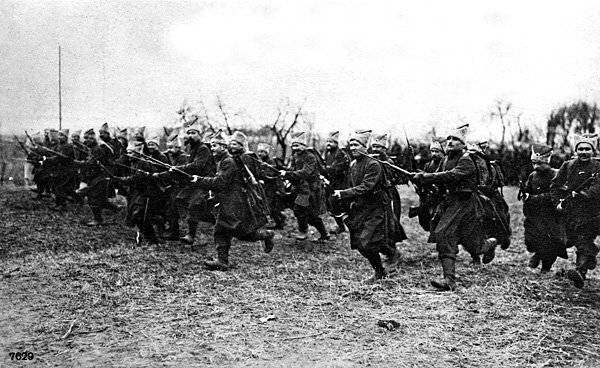
However, as soon as the members of the Makhnovist headquarters were about to go back, they got into the car, when armed Petliurists burst in on them. An enraged Gorobets waved a telegram announcing that Makhno had occupied Sinelnikovo and cut down a republican company. Chubenko managed to convince the Petliurist commissar that this was a provocation, and the Makhnovists were released. But on the way back in Nizhnedneprovsk, they were also very unfriendly met by the Bolshevik allies. Why did they go to the Petliurites? Chubenko had to reveal the secret: initially, no alliance with the nationalists was planned, the agreement was a fiction, in order to get weapons and ammunition from the authorities of the UNR. However, the Bolsheviks were not very convinced. But they nevertheless accepted the Makhnovist delegate to the Yekaterinoslav Provincial Revolutionary Committee.
However, very soon Makhno showed the Petliurists and proved to the communists what this treaty was worth - on December 27, his advanced detachments, together with the Bolsheviks, under the guise of road workers, penetrated Yekaterinoslav and suddenly collapsed on parts of the UNR. After a fierce battle, Yekaterinoslav was recaptured from the Petliurists. Although soon the rebels, who suffered heavy losses, had to leave the provincial center, the question of their relationship with the Ukrainian Republic was completely clear.
On February 12, 1919, the Second Congress of front-line rebels, workers' and peasants' councils of the Gulyai-Polye region took place, at which the Petliurists, along with Skoropadsky's supporters, were not called other than "executioners and robbers who encroached on the freedom of the Ukrainian working people." But at the congress, the question of the attitude towards the UNR nevertheless surfaced. The representative of the insurgent army, Lavrov, a member of the presidium of the congress, reported the following: “The government of the Directory mobilized soldiers to fight the scourge; but in view of the fact that the people did not stop at the platform of building a new life by the Directory, but went further, and not wanting to wage a fratricidal war, authorized the delegation to find out at the headquarters of Father Makhno whether he was making contact with Petlyura and whether it was possible to get to the Ukrainian People's Directory. The answer was received from Makhno that he did not enter into any agreements with Petliura and that it was impossible to get to the Directory due to hostilities.
Deciphering the official account of events, one should take into account that in the Makhnovist movement itself and among the population of the controlled area, the attitude towards the UNR could also be ambiguous. The Makhnovist army cannot be called purely anarchist - it was a mass insurrectionary peasant movement with a variety of moods, up to anti-Semitic ones. And above all, Makhno himself, his headquarters and the Gulyai-Polye group of anarchist-communists brought organization and a clear ideology into it. Therefore, it can be assumed that behind the radical phraseology of the Makhnovist Lavrov hides the desire of part of the front-line soldiers for an alliance with the Petliurist Directory - and not only in order to avoid a "fratricidal war." It’s just that parts of the “possible” peasantry of the Yekaterinoslav region, the model of a moderately social democratic national state could be much closer to the Makhnovist, albeit free, but Soviet commune. However, the force was behind the field commanders of the Gulyai-Polye group, who considered themselves anarchists, and the "uncles" - front-line soldiers from Bolshaya Mikhailovka had to go to the Workers' and Peasants' Provisional Government in Kharkov instead of the People's Directory.
Makhno and Petlyura - two stepsons of the Ukrainian revolution
Why was an alliance between Makhno and Petliura impossible? After all, if you look at these most prominent leaders of the era of the civil war in Ukraine, you can find a lot of similarities in them. However, there are even more irreconcilable differences between them. Although both of them come from the Left Bank, only Petlyura is from the "heart of Ukraine", the traditionalist Poltava, and Makhno is from the violent Cossack Zaporozhye region. But Petliura comes from a wealthy petty-bourgeois family, a seminary student. And Makhno is from the peasant poor. Before Petliura, there was a real choice to become a priest, an official, or join the revolution. For Makhno, the only alternative to revolutionary activity was the unenviable share of a farm laborer of a Ukrainian landowner or a worker for a Jewish entrepreneur.
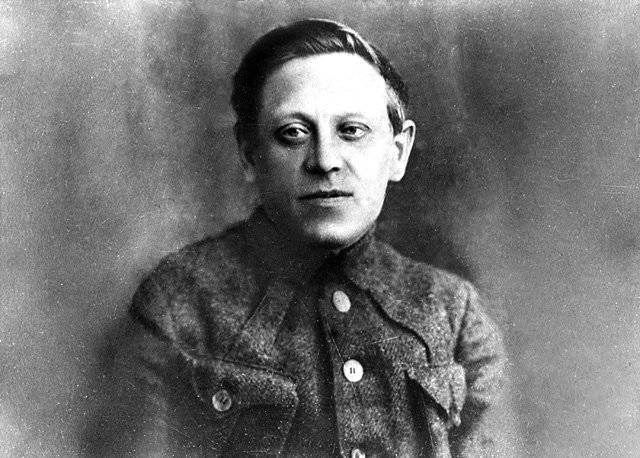
And in the revolution, based on their initial "starting opportunities", they went different ways. Educated Petlyura from the very beginning made a career in the leadership of the RUP-USDRP. He also had an "alternate airfield" - the specialty of an accountant and editorial work. And after the defeat of the revolution of 1905-1907, Petlyura, untainted by the "ex" and militantism, switched to professional activity. But Makhno from the very beginning was forced to make his way with a revolver in his hands. And after the defeat of the revolution, he simply had no choice, he could no longer lay down his arms. Therefore, the education of Makhno, who miraculously escaped the “hanger”, had to be received in the Butyrka prison castle. By and large, even after the February Revolution and liberation, not so much has changed for him - no one was waiting for the former political prisoner from the provinces either in the Duma or in the Central Rada. But the strength and authority of the revolutionary Soviets grew precisely from the seething energy of such figures as Nestor Ivanovich.
Could such different personalities agree? If it depended only on themselves, then perhaps. But behind them stood their entourage, parties, organizations and, most importantly, those masses of people whose interests they expressed. Behind Old Man Makhno are the majority of the peasantry and part of the workers of the south-east of Ukraine. Behind the head ataman Petliura are the intelligentsia, Ukrainianized officers and the wealthy part of the peasantry, mainly from Central Ukraine. According to all social concepts of that time, a union between them was impossible. But the chaos of the military situation dictated its own rules.
Batko vs Ataman
At the same time, in the south of Ukraine, the star of another field commander, Ataman Grigoriev, rises. A former officer in the tsarist army, he serves with Skoropadsky, but takes an active part in the uprising against the hetman. Not having received the post of Minister of War in the UNR, he passes from the Petliurists to the side of the Red Army. For the capture of Odessa, Grigoriev was the third in the Soviet Republic to be awarded the Order of the Red Banner. Makhno is fourth. But Grigoriev prefers to make friends not with communists, but with left-wing socialist-revolutionary activists. This anti-Bolshevik faction and, of course, personal Napoleonic ambitions are pushing Grigoriev to speak out against the Bolsheviks. And in May 1918, he raises a rebellion that created a mortal threat to communist power in Ukraine.
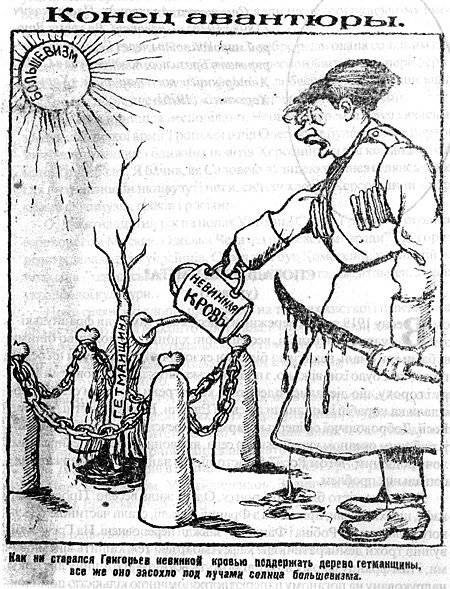
Characteristically, Grigoriev went on an uprising under nationalist slogans, but with a leftist tinge. We can say that at that moment he was “to the left” of Petliura. Grigoriev - for the Soviet Ukraine, only the Soviets should be Ukrainian. However, the Trypillia ataman Zeleny in the Kiev region and other field commanders also spoke from the positions of ultra-left nationalism. But in Ataman Grigoriev's wagon it was said that 80% of the seats in government bodies would be given to ethnic Ukrainians, and Jews, for example, only 5%. The real interest rate, as in tsarist Russia. True, Russians are not mentioned at all in this percentage. In practice, all this develops into real anti-Semitism and almost a hundred and fifty Jewish pogroms. In Yelisavetgrad and Cherkassy, the independent Grigoryevites kill, along with the Jews, several hundred Russians. Many anarchists hesitate, initially sympathizing with the "spontaneous anti-Bolshevik movement". But soon executions of anarchists also begin. In the dark heads of the Grigorievites there is a fantastic idea that it is the Anarchist-Communists who are to blame for the fact that the "good" Bolsheviks have turned into "bad" Communists.
Makhno, despite the fact that his chief of staff, the Left SR Ozerov, offers to join the uprising, refuses to support Grigoriev. And the Red Army, together with the Makhnovists, the Socialist-Revolutionaries-Borotbists, and even the anarcho-bandit Mishka Yaponchik, suppress the rebellion of another military adventurer. Grigoriev himself is hiding with a small detachment.
But soon, by order of Trotsky, Makhno would also be outlawed. Detachments of the father and chieftain will meet and conclude an alliance. But very quickly Grigoriev will be killed by the Makhnovist Alexei Chubenko, the ataman's bodyguard will be shot personally by Makhno. The revolver, from which Grigoriev was shot in a fight, according to legend, Makhno will send to Trotsky. The official pretext for the liquidation of Grigoriev is the allegedly disclosed connections of the ataman with Denikin. In reality, one of the reasons was, apparently, the personal rivalry of the two leaders.
Makhno and Grigoriev are also complete antipodes, although both are peasant leaders. Makhno is a peasant worker, Grigoriev is a military caste. Makhno is a spontaneous leader, leading on behalf of the masses, Grigoriev is a local Bonaparte. Grigoriev sees the main enemy in the Communists, and Makhno in the White Guards and landlords. Ataman Grigoriev, in the struggle for power, tries to rely on anti-Semitic sentiments, Makhno is shot for Jewish pogroms.
Grigoriev's rebellion had one serious consequence - it forced the Bolsheviks to sharply limit the sovereignty of Ukraine within the framework of the military-political union of the Soviet republics.
Union of Makhno and Petliura - 2
Makhno was always unpredictable, both for the allies and for opponents. Petliura also nearly had the fate of ataman Grigoriev.
Even during his friendship with Grigoriev, associated with the Directory of the UNR, on June 27, 1919, the Petliurist commissar arrived at Makhno's headquarters. The envoy of the head ataman promised to forget Yekaterinoslav and again offered an alliance to the Makhnovists. Makhno went to him, hoping to again receive weapons from the UNR army. A delegate from the Makhnovists Shpot, who had a typical Ukrainian appearance and spoke Ukrainian well, was sent to the Petliura headquarters. But this time, the Petliurists were more cunning and were in no hurry to help the rebels with weapons.
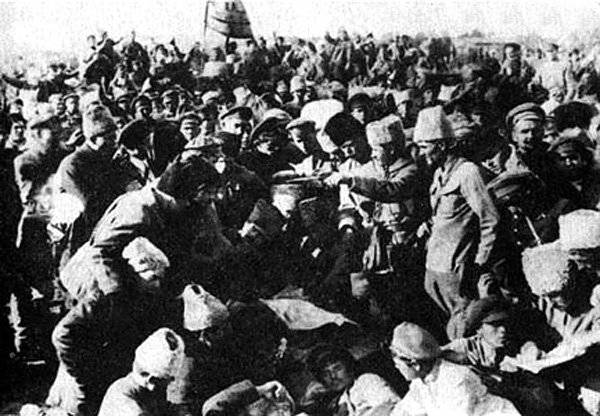
In September 1919, the Makhnovist formations were transformed into the Revolutionary Insurgent Army of Ukraine, but found themselves in a difficult situation. Denikin, clearing the road to Moscow, led a continuous offensive against the rebels. After a 600-kilometer exhausting retreat from Mariupol to the northwest, the Makhnovist army found itself sandwiched between Denikin and Petliurists in the Zhmerinka-Uman region. Makhno preferred an alliance with Petlyura to a war on two fronts. For negotiations with the Directory, a special diplomatic commission was created, headed by Alexei Chubenko, a specialist in Grigorievism. On September 20, in Zhmerinka, a new agreement was signed between the Directory of the UNR and the Revolutionary Military Council of the RPAU Makhnovists on a joint struggle against Denikin. True, Vsevolod Volin, who headed the Kulprosvet RVS of the Makhnovist army, prefers in his memoirs to speak of it as an agreement on neutrality, and not about an alliance. Ashamed, probably, even of a forced alliance with the nationalists.
Nevertheless, according to this alliance, the Makhnovists received ammunition and equipment, more than three thousand of their sick and wounded were placed in the hospitals of the UNR in Vinnitsa, Zhmerinka and Galicia. However, the clause on mutual freedom of agitation was rejected - Petlyura was afraid that the preachers of anarcho-communism and a tempting life without landowners, officials and capitalists would quickly disintegrate his army. Despite this, on the day the agreement was signed, the Makhnovists issued a revealing leaflet "Who is Petlyura?". For negotiations on freedom of speech, the chief ataman of the UNR army personally went to negotiate with Makhno in Uman. According to the chief of staff of the RPAU, Viktor Belash, the Kuban Cossack and anarcho-bolshevik Ivan Dolzhenko suggested that they treat Petlyura as Grigoriev. A terrorist group was sent to Uman and a cavalry brigade was advanced along with Makhno. But fortunately for Simon Petliura, as if anticipating something, he suddenly decided to avoid the meeting, and at the moment the Makhnovist Cavalry Brigade entered Uman, he left it on his train.
Soon the UNR army will be defeated by Denikin's troops, and the Sich Riflemen in Uman will go over to the side of "one and indivisible Russia" and surrender the city. Together they will scour hospitals and private apartments, looking for and finishing off the wounded Makhnovists. Volin generally writes that the Petliurists concluded a truce with Denikin precisely for the destruction of the Makhnovists and deliberately let five white regiments into the rear of the rebels. But in vain. Suddenly, the Makhnovist cavalry near Uman goes on the counterattack and simply cuts down the elite officer regiments. The rebels will go from here to a deep raid on Denikin's rear, which will put an end to the plans of the Commander-in-Chief of the All-Union Socialist League to take Moscow.
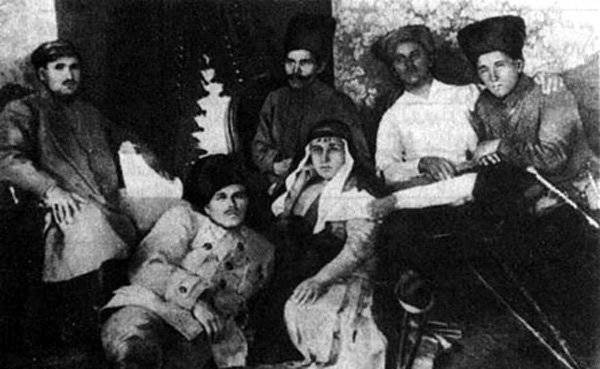
Subsequently, the RPAU headquarters tried to recruit part of the Petliurists into its ranks. Makhno opposed this. But the pragmatic chief of staff Belash was a supporter of using the Petliurists against Denikin. He writes that in November 1919, Yuri Tyutyunnik arrived at the Makhnovist headquarters, in fact the second man in the army of the UNR, and the Left SRs who were part of the leadership of this army. They asked for weapons to organize insurgent detachments in the Kiev region. But Makhno is implacable. “The UNR is our class enemy. I will not allow a single rifle to be released from the army for this imperialist vassal, ”the old man shouts at the delegation, and she has to leave with nothing. It is possible that Makhno was influenced by the unfortunate example of the left SR, a supporter of the UNR, Blakitny-Elansky, who received weapons from the Makhnovists, but under Chigirin called his detachment Republican troops. At the same time, such former supporters of the UNR as Matyazh, Gladchenko, Melashko, Ogiy and others joined the Makhnovist army, began to call themselves anarchists and enemies of Petliura. So, Gladchenko headed the Free-Cossack rebel group of the Yekaterinoslav region as part of the 3rd Yekaterinoslav Corps of the RPAU.
Batko Makhno - Ukrainian independentist?
Nevertheless, today more and more attempts are being made to portray Nestor Makhno as a Ukrainian "nezalezhnik", hardly as the second Simon Petliura. Of course, this is a tribute to political conjuncture. But what is this interpretation based on, even more voluntarily, than the Gulyaypol Soviets?
Indeed, at the last stage of the Makhnovist movement in 1920-1921, a certain growth of national self-consciousness began to be observed in it. But one cannot say that the Makhnovists were originally "rootless cosmopolitans." Despite all the internationalist rhetoric, they always felt like Ukrainians. In 1918, a certain Free Anarchist Partisan Detachment published the following leaflet: “Arise, Ukrainian people! Stand up for the defense of Free Ukraine. Every day, every hour, your enemy, the German and Russian bourgeoisie with the traitorous Haidamaks, is taking more and more: your flowering gardens, rich fields, houses, forests, taking your brothers, sisters, wives, children into their tentacles. Remember your ancestors, Taras Bulba, who fought like lions for the dear Freedom of Ukraine. Otherwise, you will not hear the nightingale's song over your hut, but the bourgeois whip will whistle.
In October 1919, the Makhnovists lifted the ban of the White General Mai-Maevsky on the study of the "mother language" at school. But at the same time, the delegates of the Fourth District Congress in Hulyaypole refuse to discuss further the question of the relationship between the Russian and Ukrainian languages in Ukraine, leaving its solution to the broad worker-peasant congresses of the near future. They understand how sensitive and subtle this issue is in the southeast, populated by Ukrainians, Russians, Germans, Greeks, Serbs, Jews, Bulgarians. But soon in this very future, the section of Public Education, headed by Makhno's wife Galina Kuzmenko, a teacher of the Ukrainian language from the Gulyai-Polye gymnasium and a conscious Ukrainian, will nevertheless launch a vigorous activity to popularize the Ukrainian language, Ukrainian theater, literature, and so on. The propaganda literature of the Makhnovists began to be published in Ukrainian. It is the authorship of Galina Kuzmenko, for example, that is attributed to a leaflet signed by Nestor Makhno on September 29, 1920: “Hard hours have come to dear Ukraine. I'm starting to storm the tormented fatherland, gloomy storms are coming. The Polish nobility, hated by the skin of Ukrainians and historical enemy, is about to enter...” This leaflet, however, is dedicated to the alliance of the Makhnovists with the Red Army to fight pan Poland. But Ida Mett, who knew Makhno well from her Parisian emigration, claims in her memoirs that Kuzmenko “belonged rather to the Petliurists and never had anything in common with the revolutionary movement.” Many attribute this characteristic of Mette to ordinary female jealousy. But sometimes in the diary of Galina Kuzmenko, written in Ukrainian and captured by the Red Army, the following lines slip through: “The Pavlovites sent two peasants in pursuit of Makhno, so that he would come with his detachment and help the villagers drive away the Russian robbers and rapists.”
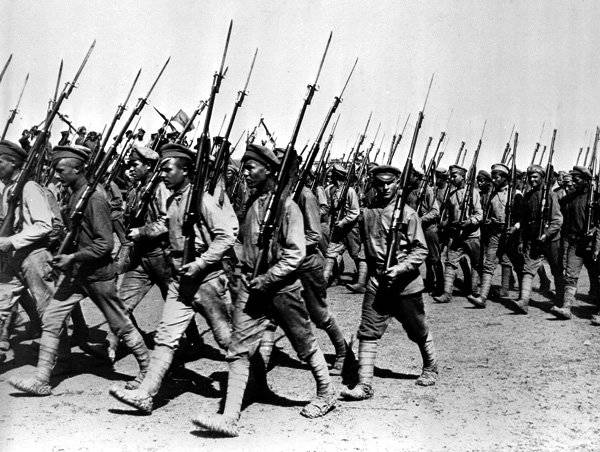
So what is the reason for the "Ukrainian turn" in the Makhnovist army? Did the former chieftains of the UNR bring the national idea there? Or was it the department of education under the leadership of Nestor Ivanovich's wife that had such an influence, including on the father himself? Of course, almost any wife has a strong influence on her husband. But no matter how decisive and charming the “first lady” was, she could not influence the entire Gulyai-Polye regional organization of anarchist-communists, the executor of whose will was Makhno. It's just that in 1920 the main competitors of the Gulyai-Polye insurgent group among the peasants of Ukraine - the field commanders of the Petliurist persuasion - were heavily bled red. Under these conditions, it no longer seemed that the Ukrainian idea would play into the hands of these "social traitors." Attracting the peasant masses who followed them, especially in central Ukraine, where the RPAU tried to spread its activity, required certain steps to meet their national sentiments. Moreover, Nestor Makhno, driven out of Soviet Ukraine by the red cavalry, plans to move his activities to Polish-occupied Galicia and raise an uprising for independence there. It is possible that a certain “Nezalezhniki manifesto” is connected with this, which Makhno prepared, but did not have time to print because of his flight to Romania in August 1921. The existence of this manifesto is mentioned by Viktor Belash in his testimony to the Chekists, but such sources should be treated critically.
At the same time, Makhno, as a faithful spokesman of the moods of the multinational southeast of Ukraine, as well as the Gulyaypole anarchist group, like the entire international anarchist movement of that time, have always been irreconcilable opponents of any nationalism and interethnic hostility from whatever they come from.
And the leader of the Ukrainian nationalists Petlyura 25 in May, 1926, will fall from the bullets of the Jewish anarchist Schwarzbad, who is familiar with Makhno. Shvartsbad will declare that he shot the former head ataman for pogroms. Makhno terrorist attack against his old opponent does not approve. He admits that Petlyura was not a mob, and will publicly condemn this murder in the press.
Information